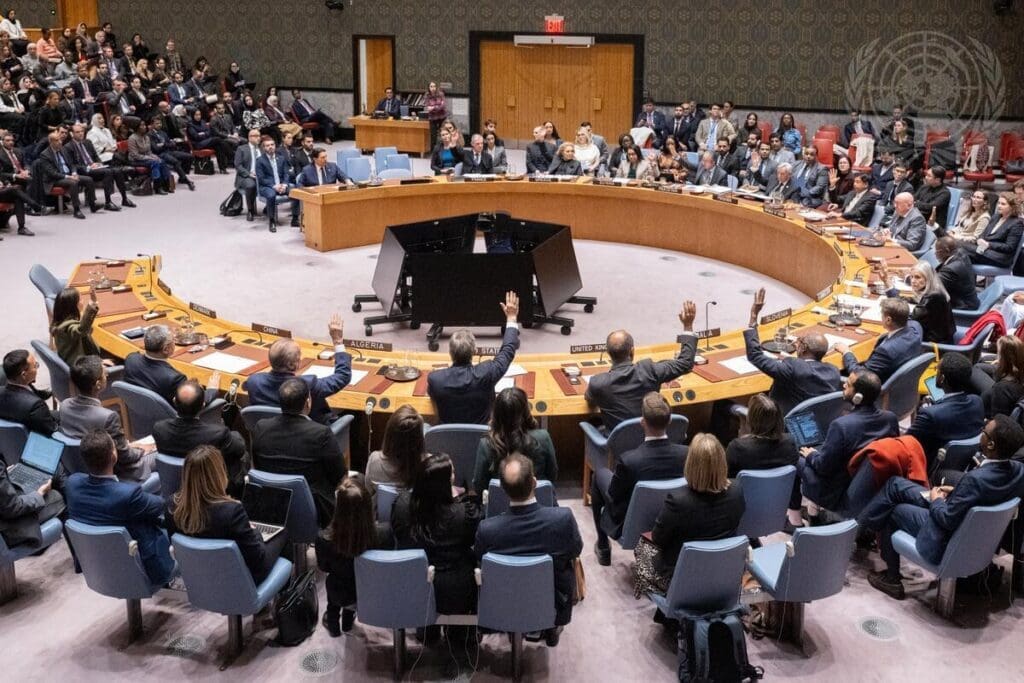
Executive Summary
Disinformation is being produced at industrial scale by official Israeli sources to justify its ongoing genocide in Gaza. Journalists and open-source intelligence analysts have only added fuel to this fire of Palestinian dehumanization by propping up the false news without necessary scrutiny. In his latest policy brief, Tariq Kenney-Shawa delves into Israel’s information warfare tactics, exploring how these efforts have contributed to the decay of truth and how they hamper efforts to organize a global response. He offers recommendations for reporters, analysts, and the wider public to leverage open-source tools to refute dominant Israeli propaganda and disinformation.
Propaganda and disinformation produced at industrial scale by official Israeli government and military sources are being legitimized and boosted by a wide network of journalists and open-source intelligence (OSINT) analysts, who have discarded all vestiges of objectivity and analytical rigor in their coverage. Instead of bearing witness to Israeli war crimes and questioning the narratives put forth by a regime engaging in genocide, they have become complicit in them. As a result, Israeli information operations are benefiting from a media network acting not as unbiased reporters, but as enablers of Israeli mass atrocities.
With an international audience primed to treat Palestinian claims with skepticism from the outset, Israeli state-sponsored disinformation campaigns have become a critical tool in justifying war crimes. This strategy is centered on convincing foreign governments and the wider public that Palestinian resistance groups use civilians as human shields and civilian infrastructure for military purposes, rendering them legitimate targets. Nowhere has this been more pronounced than in Israel’s systematic assault on Gaza’s hospitals and health infrastructure since October 7th, 2023.
When it comes to public opinion, much of the proclivity to exceptionalize Israeli war crimes is due to the failure of journalists to critically analyze Israeli narratives against the backdrop of Israel’s history of disinformation, even when open-source investigative tools readily contradict their claims. Indeed, Israel's disinformation tactics would not be as successful as they are without the complicity of journalists and OSINT analysts. Rather than challenging and debunking false claims, many have abandoned objectivity and journalistic rigor and instead act as mouthpieces for the Israeli military.
Israel’s information warfare tactics, deeply ingrained in the nation’s military and political ethos, serve as a stark reminder of the power of narrative control in facilitating mass atrocities. The case of Gaza presents a microcosm of a broader, global challenge: how to navigate and counter state-sponsored disinformation in a hyper-connected world.
Recommendations:
- Civil society and NGOs should collaborate to enhance media literacy and offer training opportunities designed to educate the general public on how to identify disinformation and propaganda.
- Media organizations and journalists should adhere to widely recognized journalistic and editorial standards when it comes to fact-checking and source verification, especially during conflicts characterized by rampant human rights abuses and war crimes.
- The UN and other international bodies should establish a task force to monitor and document instances of Israeli state-sponsored disinformation designed to dehumanize Palestinians and justify mass killing.
- Social media companies must take action to address their role in facilitating the spread of disinformation and propaganda that dehumanize Palestinians and justify war crimes. This includes implementing robust fact-checking mechanisms, enhancing transparency in content moderation efforts, collaborating with independent fact-checkers, strengthening community standards, and amplifying Palestinian voices, rather than censoring them.
Introduction
During campaigns of genocide and ethnic cleansing, disinformation is a potent weapon—a tool to dehumanize victims, justify mass violence, and most importantly, sow seeds of doubt designed to muzzle calls for intervention. When information is weaponized, confusion and doubt no longer emerge from the “fog of war” as a symptom, but are purposefully cultivated with the explicit intention of creating it.1
At the time of writing, Israeli forces have killed over 30,000 Palestinians across Gaza and the West Bank since October 2023. They have targeted hospitals, schools, and civilians fleeing their homes. Israel’s assault is marked not only by the historic scale of violence being inflicted upon Palestinians, but by the unprecedented flood of disinformation being deployed to justify it.
Propaganda and disinformation produced at industrial scale by official Israeli government and military sources are being legitimized and boosted by a wide network of journalists and open-source intelligence (OSINT) analysts, who have discarded all vestiges of objectivity and analytical rigor in their coverage. Instead of bearing witness to Israeli war crimes and questioning the narratives put forth by a regime engaging in genocide, they have become complicit in them. As a result, Israeli information operations are benefiting from a media network acting not as unbiased reporters, but as enablers of Israeli mass atrocities.
This policy brief explores the information warfare tactics Israel has used to influence public perception of its ongoing genocide in Gaza, how these efforts have contributed to the decay of truth, and how they hamper efforts to organize a global response. It also explains how journalists and open-source intelligence analysts have become active enablers of Israeli war crimes by acting as uncritical conduits of Israeli propaganda. Finally, it offers recommendations for reporters, analysts, and the wider public to leverage open-source tools to refute dominant Israeli propaganda and disinformation.
Hasbara: A Long-Running Strategy
Israel has long recognized the information environment as a critical battle front to justify the perpetual oppressive structures of occupation and apartheid. “Hasbara,” which translates to “explaining” in Hebrew, has long embodied this recognition. Rooted in pre-existing concepts of state-sponsored propaganda, agitprop, and information warfare, hasbara aims to shape the very parameters of acceptable discourse. This involves a coordinated effort by both state institutions and NGOs to bolster Israeli domestic unity, secure support of allies, and influence how media, intellectuals, and influencers discuss Israel.
Israel has long recognized the information environment as a critical battle front to justify the perpetual oppressive structures of occupation and apartheidCLICK TO TWEET
For years, Israel’s hasbara efforts were coordinated by government bodies, such as the Ministry of Strategic Affairs. After the ministry’s closure in 2021, the Israeli cabinet approved a NIS 100 million ($30 million) project aimed at adapting Israeli hasbara for an evolving global audience. The initiative, led by then-Foreign Minister Yair Lapid, funneled funds indirectly to foreign entities, ranging from social media influencers to media-watch organizations, that would disseminate pro-Israel propaganda while concealing direct ties to the Israeli government. These concerted efforts seek to establish cognitive filters that validate Israeli interests while discrediting opposing narratives on Israeli settler colonialism and its systemic violence.
In adapting to an information-rich environment, hasbarists do not solely seek to block access to information but rather guide audiences towards selective interpretation. For over 75 years, they have cast Israel as the perpetual victim, despite its military dominance and role as occupier, and are now deploying the same tactics to justify genocide in Gaza. By accusing Hamas of using Palestinians in Gaza as “human shields,” painting Palestinian resistance groups as existential threats akin to the Nazis and ISIS, or smearing victims of Israeli air strikes as “crisis actors,” hasbara aims to justify the unjustifiable.
Sowing Seeds of Doubt
Before the digital age, it was easier for Israel to discredit Palestinian claims by denying them outright. But the advent of the 24/7 news cycle and social media allowed images of Israeli atrocities to traverse the world at the speed of information, forcing Israeli hasbarists to change tactics.
On September 30, 2000, 12-year-old Muhammad al-Durrah was shot and killed by Israeli forces during a gun battle between Israeli soldiers and Palestinian security forces. The moment of Muhammad’s death, which was caught on camera, marked the birth of the hasbara term “Pallywood,” a racist smear that accuses Palestinians of acting out fake atrocities to blame on Israelis.
Unable to deny Muhammed’s killing outright, Israeli propagandists resorted to delegitimizing the source altogether. After footage of Muhammad’s death went viral, Israelis insisted that he was a crisis actor and that his death was a hoax. It did not matter that Muhammad’s father buried his son with his own hands, nor did it matter that the murder was caught on video and confirmed by eyewitnesses. What mattered was that all Palestinian claims henceforth would be tainted by doubt, subjected to heightened scrutiny, or written off outright.
The primary targets of Israeli disinformation are the two constituencies that matter most to Israel’s leaders: the Israeli public and Western audiencesCLICK TO TWEET
During the years that followed, the practice of portraying Palestinian victims of Israeli war crimes as crisis actors evolved from a conspiratorial fringe tactic to an official Israeli government strategy. On October 13, 2023, the official X account of the State of Israel posted a video of a dead Palestinian child, wrapped in a white burial shroud, claiming it was a doll planted by Hamas. Only after the original uploader of the video was tracked down, the child identified, and additional evidence shared, was the libelous post deleted without official explanation or retraction. By then, the fake news had already garnered millions of views and the damage was done. Henceforth, all images of dead Palestinian children would be written off by an audience primed to doubt their authenticity.
The next month, a spokesperson for Israeli Prime Minister Benjamin Netanyahu was called out for attempting to pass off footage from a Lebanese film as evidence that Palestinians were faking injuries from Israeli attacks. The post remained up for days, despite an X community note and a BBC debunk. “Pallywood” smears have also been leveled at popular influencers in an attempt to discredit them. For example, viral posts from official Israeli social media accounts claimed that Saleh Aljafarawi, a popular influencer who has been covering Israel’s assault on Gaza, staged fake injuries at a hospital. This was likewise later debunked, as the footage was proven to instead be of Mohammed Zendiq, a young man injured during an Israeli incursion in the West Bank.
Of course, Israeli claims of “Pallywood” propaganda were never designed to withstand even rudimentary fact-checking and scrutiny. But in an age in which over 50% of US adults get their news from social media and an even higher number do not read past headlines, Israeli disinformation can become engrained long before it is debunked. One study found that 86 percent of people do not fact-check news they see on social media. Another study found that the volume of social media posts citing Pallywood “increased steadily in the days after October 7”, and that the term was mentioned over 146,000 times between October 7th and October 27th.
The primary targets of Israeli disinformation are the two constituencies that matter most to Israel’s leaders: the Israeli public and Western audiences. In a battle for sympathy, the truth is rarely a requisite. Sometimes all it takes is a headline that captures attention and confirms preexisting biases.
Justifying War Crimes
With an international audience primed to treat Palestinian claims with skepticism from the outset, Israeli state-sponsored disinformation campaigns have become a critical tool in justifying war crimes. This strategy is centered on convincing foreign governments and the wider public that Palestinian resistance groups use civilians as human shields and civilian infrastructure for military purposes, rendering them legitimate targets. Nowhere has this been more pronounced than in Israel’s systematic assault on Gaza’s hospitals and health infrastructure since October 7th, 2023.
(Israel’s) strategy is centered on convincing foreign governments and the wider public that Palestinian resistance groups use civilians as human shields and civilian infrastructure for military purposes, rendering them legitimate targetsCLICK TO TWEET
On October 27th, the Israeli military’s official X account posted a 3D rendition of an elaborate labyrinth of tunnels and bunkers underneath Al-Shifa Hospital, alleging Hamas was using it as a command center. Their claims were specific: Al-Shifa was the “beating heart” of Hamas’s command infrastructure, and several hospital buildings sat directly atop tunnels that could be accessed from hospital wards. Israel provided no evidence to back up their claims, but that did not stop the Biden Administration from unequivocally repeating the Israeli narrative. Speaking to reporters a day before Israeli forces stormed the hospital, John Kirby, a US National Security Council spokesperson, insisted that not only did “Hamas and the Palestinian Islamic Jihad (PIJ) members operate a command-and-control node from Al-Shifa,” but that they were using the hospital to “hold hostages” and were “prepared to respond to an Israeli military operation.” Like the Israeli military, Kirby presented no evidence to back up his statement.
On November 15th, Israeli forces stormed Al-Shifa hospital, hours after the Biden Administration had effectively given them the green light. What they found fell far short of their far-reaching claims. While Israeli forces did uncover a tunnel that ran under a corner of the hospital compound, none of the hospital buildings were connected to the tunnel network—which showed no signs of military use—and there was no evidence of access from hospital wards. Hamas fighters never mobilized en masse to defend the facility from within, as US intelligence predicted. There were no signs of hostages and, most importantly, no command center.
While Al-Shifa represents the cornerstone of Israel’s disinformation campaign against Palestinian health infrastructure, it is far from the only target. Israeli forces have carried out over 500 attacks on healthcare workers and infrastructure across Gaza and the West Bank since October 7th, averaging about 7 attacks per day. These numbers include attacks on hospitals and clinics, healthcare personnel, ambulances, patients, and medical aid stations. By planting the idea, regardless of its veracity, that Hamas and other resistance groups might be using hospitals for military purposes, Israel casts a shadow of doubt over whether Gaza’s entire health system enjoys the protections afforded by international humanitarian law. In doing so, Israel transforms the perception of attacks on hospitals from a brazen violation of international law to a norm.
Journalists and OSINT Analysts as Enablers
While the last three months reveal how uniquely callous and crude Israel’s information manipulation tactics are, they are not new. In fact, many of the Israeli talking points we have become so familiar with today are eerily reminiscent of the rhetoric the US employed to justify civilian massacres in Vietnam. But while much of the political establishment in the West has come to widely condemn the indiscriminate bombing campaigns, the use of internationally prohibited munitions, and the collective punishment of civilians by US forces in Vietnam, they now justify Israel’s use of the same tactics in Gaza.
When it comes to public opinion, much of the proclivity to exceptionalize Israeli war crimes is due to the failure of journalists to critically analyze Israeli narratives against the backdrop of Israel’s history of disinformation, even when open-source investigative tools readily contradict their claims. Indeed, Israel’s disinformation tactics would not be as successful as they are without the complicity of journalists and OSINT analysts. Rather than challenging and debunking false claims, many have abandoned objectivity and journalistic rigor and instead act as mouthpieces for the Israeli military.
When it comes to public opinion, much of the proclivity to exceptionalize Israeli war crimes is due to the failure of journalists to critically analyze Israeli narratives against the backdrop of Israel’s history of disinformationCLICK TO TWEET
Journalists today enjoy two key advantages that those covering the Vietnam war did not have: the benefits of hindsight and the verification tools provided by OSINT analysis. Instead of treating Israeli claims with inherent skepticism, seasoned journalists are acquiescing to Israeli censorship and narrative control. In November, CNN’s White House correspondent Jeremy Diamond joined a small number of journalists, including ABC’s Ian Pannell and Fox News’s Trey Yingst, in announcing that they would be covering the “Israel-Hamas war” from inside Gaza—but under serious limitations: “As a condition to enter Gaza under IDF escort, outlets have to submit all materials and footage to the Israeli military for review prior to publication,” said Becky Anderson, who introduced Diamond’s report. While there is nothing new about journalists embedding with armed forces, Israel’s required screening and censorship of reporting stand out when compared to other militaries. Indeed, even the US military did not explicitly mandate that journalists embedded with its forces in Iraq submit all of their reporting for approval prior to publishing, except in select cases involving classified information.
Effective journalism requires constant verification and fact-checking, informed by an instinct for skepticism. By accepting Israel’s uniquely onerous censorship terms in Gaza, journalists are doing more harm than good. The information Israel allows to be published is carefully selected to justify the targeting and killing of Palestinian civilians, and by only reporting the approved narrative of a military currently engaged in genocide, journalists are effectively giving a platform to war crimes justifications. Uncritically regurgitating unverified claims made by a military with a history of information manipulation in the midst of a genocide is not journalism; it is stenography.
Unobjective OSINT Analysts
As traditional journalism fails the tests of objectivity, OSINT once again finds itself in the spotlight. Over recent years, OSINT has emerged as a trusted source of news and objective analysis amid waning confidence in state institutions and traditional media. Much of this is due to the traceable, transparent nature of open-source investigations, which has made OSINT analysts popular sources of news and situational analysis for journalists, lawmakers, and the public alike.
Open-source investigations have been pivotal in countering Israeli state-sponsored disinformation. In one instance, a New York Times investigation refuted Israeli claims that a misfired Palestinian rocket hit Al-Shifa Hospital courtyard on November 10th, revealing that the projectile was, in fact, an Israeli artillery shell. This exposed not only Israeli responsibility for the strike but also their deceptive tactics, which went as far as providing a false mockup of radar data to deceive the media.
While OSINT has once again proven to be an integral tool in war crimes investigations by circumventing Israeli access denial and debunking disinformation, some popular OSINT accounts have discarded their facades of objectivity. While this is indicative of wider trends in the deteriorating information environment on social media, a growing number of popular OSINT accounts are using their far-reaching platforms to peddle Israeli disinformation and even cover up Israeli war crimes.
Perhaps the most obvious example of this is an X account by the name of OSINT Defender. A self-described “Open Source Intelligence Monitor focused on Europe and Conflicts across the World,” OSINT Defender gained prominence covering the war in Ukraine. Recent investigations have revealed OSINT Defender’s identity as Simon Anderson, a member of the US military and resident of the state of Georgia. Since October 7th, the account has developed a reputation for sharing Israeli disinformation, dehumanizing Palestinians, and justifying Israeli war crimes.
OSINT Defender has shared debunked Israeli claims of the alleged Hamas command center under Al-Shifa and described hundreds of Palestinian civilians rounded up and tortured by Israeli forces as “Hamas terrorists.” The Israeli military itself later admitted that those rounded up were indeed civilians, but OSINT Defender never retracted the original posts. He has also fueled racist “Pallywood” tropes and routinely describes peaceful protesters calling for a ceasefire as violent “Hamas supporters.” If that wasn’t enough, Anderson also claimed that the group of journalists killed by an Israeli tank shell in southern Lebanon were filming “current exchanges of fire,” when in reality, no active combat was ongoing at the time they were targeted. In none of these cases has OSINT Defender publicly retracted or corrected the false claims, even when debunked.
While experienced analysts and journalists may be able to identify the disinformation and engagement farming that accounts like OSINT Defender are known for, the same cannot be said for the general public. Their understanding of Israel’s assault on Gaza continues to be shaped by analysts assumed to be objective who, in reality, act as an extended arm of the Israeli propaganda machine. For example, accounts such as Aleph א and Israel Radar provide more technical analysis of developments throughout the region, but never question Israeli military narratives or correct Israeli disinformation, even when it is publicly debunked. They routinely fact check other accounts for sharing disinformation, but give the Israeli military a pass from the same verification process. For example, while pro-Israel accounts were quick to share Israel’s fabricated radar data mockup that claimed misfired Palestinian rockets struck Al-Shifa on November 10th, they were nowhere to be seen when subsequent investigations debunked it.
Conclusion
Israel’s strategy in Gaza is not limited to dehumanizing Palestinians and justifying war crimes under the guise of self-defense. In addition to saturating the information environment with an unprecedented deluge of state-sponsored disinformation, Israel has further isolated Gaza by deliberately targeting and destroying communications infrastructure. The resulting communications blackouts have thrust Gaza further into the dark, making it increasingly difficult for Palestinians to share evidence of Israeli war crimes with the outside world. As a result, efforts to push back against Israeli disinformation are severely hindered and Israeli propaganda can run amok.
Israel’s near-total control of the information environment is further compounded by the global network of journalists and OSINT analysts who, wittingly or unwittingly, act as uncritical conduits for pro-Israel and anti-Palestinian narratives. This phenomenon underscores a dangerous precedent, where the rapid dissemination of information—or disinformation—can shape international perceptions in real time before thorough verification or counter-narratives can take hold.
Moreover, Israel’s information warfare tactics, deeply ingrained in the nation’s military and political ethos, serve as a stark reminder of the power of narrative control in facilitating mass atrocities. The case of Gaza presents a microcosm of a broader, global challenge: how to navigate and counter state-sponsored disinformation in a hyper-connected world.
Recommendations:
- Civil society and NGOs should collaborate to enhance media literacy and offer training opportunities designed to educate the general public on how to identify disinformation and propaganda. While this applies to all forms of media, training in basic OSINT collection methods would arm audiences with the tools they need to verify information as it comes out in real time. This could include training on conducting reverse image searches, geolocating footage shared online, and cross-checking information across multiple trustworthy sources. They should also advocate for increased funding of independent fact-checking organizations, such as Al-Haq and Forensic Architecture.
- Media organizations and journalists should adhere to widely recognized journalistic and editorial standards when it comes to fact-checking and source verification, especially during conflicts characterized by rampant human rights abuses and war crimes. Claims made by militaries or armed groups should be treated with heightened scrutiny. In light of access limitations imposed by Israel, it is imperative for media organizations to prioritize sourcing news content and situational updates from Palestinian sources and hiring Palestinian reporters wherever feasible.
- International law is woefully unprepared to address the evolving nature of state-sponsored disinformation in the digital age. In addition to developing wider legal frameworks to address the issue, the UN and other international bodies should establish a task force to monitor and document instances of Israeli state-sponsored disinformation designed to dehumanize Palestinians and justify mass killing. This information can be included as evidence of Israel’s genocidal intent in ongoing and future investigations.
- Social media companies must take action to address their role in facilitating the spread of disinformation and propaganda that dehumanize Palestinians and justify war crimes. This includes implementing robust fact-checking mechanisms, enhancing transparency in content moderation efforts, collaborating with independent fact-checkers, strengthening community standards, and amplifying Palestinian voices, rather than censoring them.
- To read this piece in French and Spanish, please click here and here, respectively. Al-Shabaka is grateful for the efforts by human rights advocates to translate its pieces, but is not responsible for any change in meaning.








